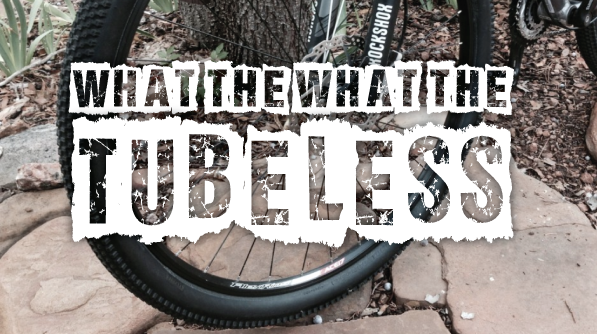In the past decade, tubeless tires have hit the bike scene in one of the biggest advances in technology (with wide-ranging side effects). In this two-part series, I’ll begin by exploring how tubeless got its foothold in the industry with mountain bikes and why it’s become almost standard in new mountain bikes today.
What are “Tubeless” Tires?
Tubeless tires are actually a system of tires and rims specially designed to not use an inner tube. Instead, a tubeless ready (TLR or TR) rim is designed to create an air-tight seal with the TLR specific tire, without needing a tube.
Most tubeless tires are designed to be used with a thin sealant inside of it to help self-seal and repair small punctures as well as make the seal between the rim and tire have an extra layer of air-tight protection.
On the exterior, tubeless rims and tires look just like regular rims.
Pros of Tubeless Mountain Bike Tires
So what’s all the fuss? Even with sealant and stout compounds, tubeless tires tend to weigh less than the traditional system, and a little less weight to push around never hurt anyone.
On standard rims, “pinch flats” (a flat where the bead of the tire would pinch the tube against the rim and cause a snake-bite looking puncture) are a common problem, especially for heavier riders. No tube? No pinch flats.
As mentioned earlier, the sealant quickly fills the void from small punctures in tubeless tires, so you may not even notice that you had a problem at all. This is especially nice if you regularly ride in areas prone to thorns or goatheads (Eastern Oregon, anyone?).
Best of all, tubeless tires offer the ability to run much lower pressures than with tubes, giving the rider improved traction without loosing any rolling resistance. This gives an overall smoother, faster ride.
Running lower pressure also keeps your tires engaged with the ground instead of bouncing around like you would with the higher pressure of tires with tubes. This allows for better grip when climbing over obstacles like roots and rocks, which makes technical climbing easier. With tubeless tires the effort you’re putting into the pedals is better transferred into the tire.
TO SUMMARIZE: with tubeless tires you can better rip down the trail, conquer rocks and roots and corner like a boss. Who doesn’t want that?
Cons of Tubeless Mountain Bike Tires
The cost of tubeless rims and tires is slightly higher than that of a traditional set up. The tire itself is harder to initially set up; it requires an air compressor and sealant, which can be messy. Your local bike shop can do this in about 10 minutes.
Tubeless requires a bit more maintenance because the sealant will eventually dry up and need to be refilled. In the Pacific Northwest you’ll want to refresh the sealant every 4- 6 months – more often if you live in a drier climate.
That sealant can be a factor if you have a flat that requires installing a tube on trail: you’ll be getting it all over your hands while you deal with the flat. The larger bead of the TLR tire is also harder to get over the wall of the rim. Not impossible, but you’ll need some quality levers and strong hands.
Myths, Deflated
When they first came onto the market for mountain bikes over a decade ago, there were a few design flaws with tubeless tires. The rim and bead designs had not been refined, so some riders, especially when running very low pressure, would break the seal between the rim and tire “burping” out air. Worse yet, the tires would sometimes roll off the rim completely at inopportune times, like when cornering hard.
But as with any technology, the bugs have long been worked out and the ride of tubeless tires is now even more dependable than tires with tubes.


Pingback: Tubeless Tires: Road Edition – ORbike: FIND ADVENTURE - Bicycle Events and Cycling Tips